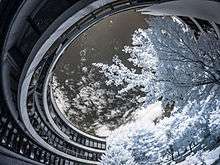Fisheye lens
A fisheye lens is an ultra wide-angle lens that produces strong visual distortion intended to create a wide panoramic or hemispherical image.[4][5]:145 Fisheye lenses achieve extremely wide angles of view. Instead of producing images with straight lines of perspective (rectilinear images), fisheye lenses use a special mapping (for example: equisolid angle), which gives images a characteristic convex non-rectilinear appearance.
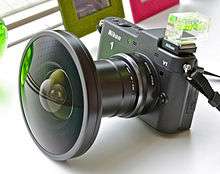 | |
| Introduced in | 1924 |
|---|---|
| Author | Wood (1905),[1] Bond (1922),[2] and Hill (1924)[3] |
| Construction | Var. elements in Var. groups |
The term fisheye was coined in 1906 by American physicist and inventor Robert W. Wood based on how a fish would see an ultrawide hemispherical view from beneath the water (a phenomenon known as Snell's window).[1][5]:145 Their first practical use was in the 1920s for use in meteorology[3][6] to study cloud formation giving them the name "whole-sky lenses". The angle of view of a fisheye lens is usually between 100 and 180 degrees[4] while the focal lengths depend on the film format they are designed for.
Mass-produced fisheye lenses for photography first appeared in the early 1960s[7] and are generally used for their unique, distorted appearance. For the popular 35 mm film format, typical focal lengths of fisheye lenses are between 8 mm and 10 mm for circular images, and 15–16 mm for full-frame images. For digital cameras using smaller electronic imagers such as 1⁄4" and 1⁄3" format CCD or CMOS sensors, the focal length of "miniature" fisheye lenses can be as short as 1 to 2 mm.
These types of lenses also have other applications such as re-projecting images that were originally filmed through a fisheye lens, or created via computer generated graphics, onto hemispherical screens. Fisheye lenses are also used for scientific photography such as recording of aurora and meteors, and to study plant canopy geometry and to calculate near-ground solar radiation. They are perhaps most commonly encountered as peephole door viewers to give the user a wide field of view.
History and development
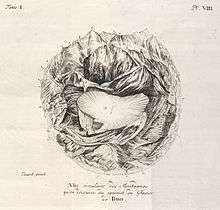
Panoramas with fisheye distortion predate the fisheye lens. In 1779, Horace Bénédict de Saussure published his downward-facing fisheye view of the Alps: "All the objects are drawn in perspective from the centre".[8]
In 1906, Wood published a paper detailing an experiment in which he built a camera in a water-filled pail starting with a photographic plate at the bottom, a short focus lens with a pinhole diaphragm located approximately halfway up the pail, and a sheet of glass at the rim to suppress ripples in the water. The experiment was Wood's attempt "to ascertain how the external world appears to the fish" and hence the title of the paper was "Fish-Eye Views, and Vision under Water".[1] Wood subsequently built an improved "horizontal" version of the camera omitting the lens, instead using a pinhole pierced in the side of a tank, which was filled with water and a photographic plate. In the text, he described a third "Fish-Eye" camera built using sheet brass, the primary advantages being that this one was more portable than the other two cameras, and was "absolutely leaktight".[1] In his conclusion, Wood thought that "the device will photograph the entire sky [so] a sunshine recorder could be made on this principle, which would require no adjustment for latitude or month" but also wryly noted "the views used for the illustration of this paper savour somewhat of the 'freak' pictures of the magazines."[1]
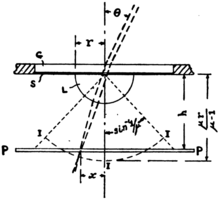
W.N. Bond described an improvement to Wood's apparatus in 1922 which replaced the tank of water with a simple hemispheric glass lens, making the camera significantly more portable. The focal length depended on the refractive index and radius of the hemispherical lens, and the maximum aperture was approximately f/50; it was not corrected for chromatic aberration and projected a curved field onto a flat plate. Bond noted the new lens could be used to record cloud cover or lightning strikes at a given location.[2] Bond's hemispheric lens also reduced the need for a pinhole aperture to ensure sharp focus, so exposure times were also reduced.[9]
Hill Sky Lens
.svg.png)
In 1924, Robin Hill first described a lens with 180° coverage that had been used for a cloud survey in September 1923[3] The lens, designed by Hill and R. & J. Beck, Ltd., was patented in December 1923.[10] The Hill Sky Lens is now credited as the first fisheye lens.[5]:146 Hill also described three different mapping functions of a lens designed to capture an entire hemisphere (stereographic, equidistant, and orthographic).[3][11] Distortion is unavoidable in a lens that encompasses an angle of view exceeding 125°, but Hill and Beck claimed in the patent that stereographic or equidistant projection were the preferred mapping functions.[10] The three-element, three-group lens design uses a highly divergent meniscus lens as the first element to bring in light over a wide view followed by a converging lens system to project the view onto a flat photographic plate.[10]
The Hill Sky Lens was fitted to a whole sky camera, typically used in a pair separated by 500 metres (1,600 ft) for stereo imaging, and equipped with a red filter for contrast; in its original form, the lens had a focal length of 0.84 in (21 mm) and cast an image 2.5 in (64 mm) in diameter at f/8.[12] Conrad Beck described the camera system in an article published in 1925.[13] At least one has been reconstructed.[14]
German and Japanese development
.svg.png)
In 1932, the German firm Allgemeine Elektricitäts-Gesellschaft AG (AEG) filed for a patent on the Weitwinkelobjektiv (wide-angle lens), a 5-element, 4-group development of the Hill Sky Lens.[5]:148 [15] Compared to the 1923 Hill Sky Lens, the 1932 Weitwinkelobjektiv featured two diverging meniscus elements ahead of the stop and used a cemented achromatic group in the converging section.[15] Miyamoto credits Dr Hans Schulz with the design of the Weitwinkelobjektiv.[11] The basic patented design was produced for cloud recording as a 17 mm f/6.3 lens,[16] and the artist known as Umbo used the AEG lens for artistic purposes, with photographs published in a 1937 issue of Volk und Welt.[17]
The AEG Weitwinkelobjektiv formed the basis of the later Fish-eye-Nikkor 16 mm f/8 lens of 1938, which was used for military and scientific (cloud cover) purposes.[16][18] Nikon, which had a contract to supply optics to the Imperial Japanese Navy, possibly gained access to the AEG design under the Pact of Steel.[18] After the war, the lens was mated to a medium format camera and was produced in slightly modified form (focal length increased slightly to 16.3 mm) as the "Sky-image Recording Camera" in March 1957 for the Japanese government,[19] followed by a commercial release as the Nikon Fisheye Camera (also known as the "Nikon Sky Camera" or "Nikon Cloud Camera") in September 1960, which had a retail price of ¥200,000 (equivalent to ¥1,130,000 in 2019).[20] The revised lens created a circular image 50 mm (2.0 in) in diameter and covered a complete hemispherical field of 180°.[21] Only 30 examples of the Nikon Fisheye Camera were manufactured, and of those, 18 were sold to customers, mainly in the United States; Nikon likely destroyed the remaining stock to avoid tax penalties.[22] A photograph of pole vaulter Bob Gutowski taken by the Fisheye Camera was published in Life in 1957.[23]
.svg.png)
Also in 1938, Robert Richter of Carl Zeiss AG patented the 6-element, 5-group Pleon lens,[24] which was used for aerial surveillance during World War II. The converging rear group of the Pleon was symmetrical, reminiscent of the 4-element Topogon design, also designed by Richter for Zeiss in 1933. Testing on a captured lens after the war showed the Pleon provided an equidistant projection to cover a field of approximately 130°, and negatives were printed using a special rectifying enlarger to eliminate distortion.[5]:149 [25] The Pleon had a focal length of approximately 72.5 mm with a maximum aperture of f/8 and used a plano-concave front element 300 mm (12 in) in diameter; the image on the negative was approximately 85 mm (3.3 in) in diameter.[25]
35mm development
At approximately the same time that Schulz was developing the Weitwinkelobjektiv at AEG, Willy Merté at Zeiss was developing the Sphaerogon, which was also designed to encompass a 180° field of view.[26][27] Unlike the Weitwinkelobjektiv, Merté's Sphaerogon was not limited to medium format cameras; prototype versions of the Sphaerogon were constructed for the Contax I miniature format camera. The first prototype Sphaerogon lenses constructed had a maximum aperture of f/8, but later examples were computed half a stop faster, to f/6.8.[28] Several prototype examples of Sphaerogon lenses were recovered as part of the Zeiss Lens Collection seized by the Army Signal Corps as war reparations in 1945;[29] the collection, which the Zeiss firm had retained as a record of their designs, was later documented by Merté, the former head of optical computation for CZJ, working under Signal Corps officer Edward Kaprelian.[30][31]
The Nikon Fisheye Camera was discontinued in September 1961,[19] and Nikon subsequently introduced the first regular production fisheye lens for miniature cameras in 1962,[11] the Fish-eye-Nikkor 8 mm f/8,[32] which required the reflex mirror on its Nikon F and Nikkormat cameras to be locked up prior to mounting the lens. Prior to the early 1960s, fisheye lenses were used primarily by professional and scientific photographers, but the advent of the fisheye for the 135 format increased its popular use.[33] The Nikkor 8 mm f/8 has a field of view of 180° and uses 9 elements in 5 groups; it is fixed focus and has built-in filters mainly intended for black-and-white photography. Research indicates that fewer than 1,400 lenses were built.[34]
Nikon subsequently released several more milestone circular fisheye lenses in Nikon F mount through the 1960s and 70s:
- 10 mm f/5.6 OP (1968), the first fisheye to feature orthographic projection, which was also the first lens to feature an aspherical element[35]
- 6 mm f/5.6 (1969), the first fisheye to feature a 220° field of view;[7] interestingly, the patent accompanying this lens includes a design for a lens with a 270° field of view.[36] A 6.2 mm f/5.6 SAP fisheye was later produced in limited numbers with an aspherical surface, encompassing a 230° field of view.[37]
- 8 mm f/2.8 (1970), the first circular fisheye with variable focus, automatic aperture, and reflex viewing (mirror lock-up no longer required).[7]
.jpg)
Meanwhile, other Japanese manufacturers were developing the so-called full-frame or diagonal fisheyes, which captured approximately a 180° field of view across the diagonal of the film frame. The first such diagonal fisheye was the Fish-eye Takumar 18 mm f/11, released by Pentax (Asahi Optical) in 1962,[37][38][39] followed by the slightly faster UW Rokkor-PG 18 mm f/9.5 from Minolta in 1966.[40] Both of these were reflex viewing and fixed-focus, and Pentax and Minolta followed up with faster lenses with variable focus in 1967 (Super Fish-eye-Takumar 17 mm f/4)[41] and 1969 (Rokkor-OK 16 mm f/2.8),[42][43] respectively. The 16 mm Rokkor was later adopted by Leica as the Fisheye-Elmarit-R (1974) and then converted to autofocus (1986) for the Alpha system. As of 2018, the same basic optical design is still sold as the Sony SAL16F28.
Design
| circular | cropped circle | full-frame | |
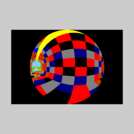 | 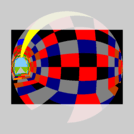 | 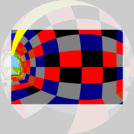 | |
| 3:2 | 52 % sensor | 78 % FOV, 92 % sensor | 59 % FOV |
| 4:3 | 59 % sensor | 86 % FOV, 90 % sensor | 61 % FOV |
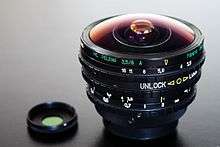 Circular fisheye for 35mm | 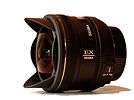 Full-frame fisheye with rudimentary lens hood | ||
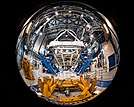 ESO's VLT image taken with a circular fisheye lens. |  35mm circular fisheye with DX-format-camera | 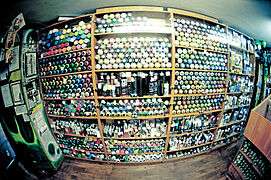 Full-frame fisheye used in a closed space (Nikkor 10.5mm) | |
In a circular fisheye lens, the image circle is inscribed in the film or sensor area; in a full-frame fisheye lens the image circle is circumscribed around the film or sensor area.
Further, different fisheye lenses distort images differently, and the manner of distortion is referred to as their mapping function. A common type for consumer use is equisolid angle.
Although there are digital fisheye effects available both in-camera and as computer software they can't extend the angle of view of the original images to the very large one of a true fisheye lens.
Focal length
The focal length is determined by the angular coverage, the specific mapping function used, and the required dimensions of the final image. Focal lengths for popular amateur camera sizes are computed as:
| Stereographic | Equidistant | Equisolid Angle | Orthographic | ||
|---|---|---|---|---|---|
| Inverse Mapping Function[44] | |||||
| Circular[lower-alpha 2] | APS-C (=8.4mm) | 4.2 | 5.3 | 5.9 | 8.4 |
| 135 (=12mm) | 6.0 | 7.6 | 8.5 | 12.0 | |
| 6×6 (=28mm) | 14.0 | 17.8 | 19.8 | 28.0 | |
| Full-frame[lower-alpha 3] | APS-C (=15.1mm) | 7.5 | 9.6 | 10.6 | 15.1 |
| 135 (=21.7mm) | 10.8 | 13.8 | 15.3 | 21.7 | |
| 6×6 (=39.6mm) | 19.8 | 25.2 | 28.0 | 39.6 | |
- Notes
- Assumes 180° maximum angle of view for the mapping function,
- For circular fisheyes, the maximum dimension is half the length of the shortest side.
- For full-frame fisheyes, the maximum dimension is half the length of the diagonal.
Circular fisheye
The first types of fisheye lenses to be developed were "circular fisheye"—lenses which took in a 180° hemisphere and projected this as a circle within the film frame. Some circular fisheyes were available in orthographic projection models for scientific applications. These have a 180° vertical angle of view, and the horizontal and diagonal angle of view are also 180°. By design, most circular fisheye lenses cover a smaller image circle than rectilinear lenses, so the corners of the frame will be completely dark.
Sigma currently makes a 4.5mm fisheye lens that captures a 180-degree field of view on a crop body.[45] Sunex also makes a 5.6mm fisheye lens that captures a circular 185-degree field of view on a 1.5x Nikon and 1.6x Canon DSLR cameras.
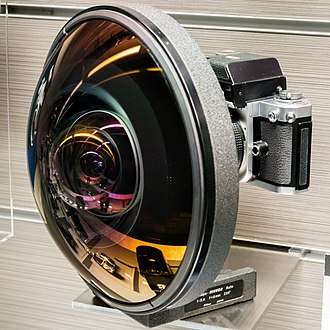
Nikon produced a 6 mm circular fisheye lens that was initially designed for an expedition to Antarctica. It featured a 220-degree field of view, designed to capture the entire sky and surrounding ground when pointed straight up. This lens is no longer manufactured by Nikon,[46] and is used nowadays to produce interactive virtual-reality images such as QuickTime VR and IPIX. Because of its very wide field of view, it is very large and cumbersome—weighing 5.2 kilograms (11 lb), having a diameter of 236 millimetres (9.3 in), a length of 171 millimetres (6.7 in) and an angle of view of 220 degrees. It dwarfs a regular 35 mm SLR camera[47] and has its own tripod mounting point, a feature normally seen in large long-focus or telephoto lenses to reduce strain on the lens mount because the lens is heavier than the camera. The lens is extremely rare.[48]

However, there are new developments by the Japanese manufacturer Entaniya for the Micro Four Thirds standard, which offer an angle of view of 250 degrees with lenses that have a focal length of 2.3 millimetres (0.091 in) to 3.6 millimetres (0.14 in), an aperture of f/2.8 to f/4.0, a weight of 1.6 kilograms (3.5 lb), a diameter of 120 millimetres (4.7 in) and a length below 100 millimetres (3.9 in).[49] In 2018 Venus Optics introduced a 210° fisheye lens for the Micro Four Thirds system.[50]
An 8 mm fisheye lens, also made by Nikon, has proven useful for scientific purposes because of its equidistant (equiangular) projection, in which distance along the radius of the circular image is proportional to zenith angle.
Full-frame fisheye
As fisheye lenses gained popularity in general photography, camera companies began manufacturing fisheye lenses that enlarged the image circle to cover the entire rectangular frame, called a "full-frame fisheye".[51]
The picture angle produced by these lenses only measures 180 degrees when measured from corner to corner: these have a 180° diagonal angle of view, while the horizontal and vertical angles of view will be smaller; for an equisolid angle-type 15 mm full-frame fisheye, the horizontal AOV will be 147°, and the vertical AOV will be 94°.[52]
One of the first full-frame fisheye lens to be mass-produced was the Fisheye-Nikkor 16mm f/3.5, made by Nikon in the early 1970s. Digital cameras with APS-C sized sensors require a 10.5 mm lens (or, for Canon APS-C cameras, a 10 mm lens) to get the same effect as a 16 mm lens on a camera with full-frame sensor.[53]
Miniature fisheye lenses
Miniature digital cameras, especially when used as security cameras, often tend to have fisheye lenses to maximize coverage. Miniature fisheye lenses are designed for small-format CCD/CMOS imagers commonly used in consumer and security cameras.[54][55] Popular image sensor format sizes used include 1⁄4", 1⁄3", and 1⁄2". Depending on the active area of the image sensor, the same lens can form a circular image on a larger image sensor (e.g. 1⁄2"), and a full frame on a smaller one (e.g. 1⁄4").
Examples and specific models
Fisheye lenses for APS-C cameras
The APS-C image sensor used in Canon cameras is 22.3 mm × 14.9 mm (0.88 in × 0.59 in) or 26.82 mm (1.056 in) on the diagonal, which is slightly smaller than the sensor size used by other popular manufacturers of cameras with APS-C sensors, such as Fuji, Minolta, Nikon, Pentax, and Sony. The other common APS-C sensors range from 23.6 to 23.7 mm (0.93 to 0.93 in) on the long dimension and 15.6 mm (0.61 in) on the shorter side, for a diagonal measurement between 28.2 to 28.4 mm (1.11 to 1.12 in).
Circular APS-C fisheye lenses
- Sigma 4.5 mm f/2.8 for APS-C sensors
- Lensbaby 5.8mm f/3.5 circular fisheye
Full-frame APS-C fisheye lenses
- Nikon 10.5 mm f/2.8
- Samyang 8 mm f/3.5. Notable for its stereographic projection
- Samyang 8 mm f/2.8. For various mirrorless cameras. Notable for its stereographic projection
- Sigma 10 mm f/2.8
Zoom APS-C fisheye lenses
- Pentax 10–17 mm f/3.5–4.5 / Tokina 10–17 mm f/3.5–4.5 (jointly developed)
Fisheye lenses for 35 mm cameras
Circular fisheye

- Peleng 8 mm f/3.5
- Sigma 8 mm f/4.0
- Sigma 8 mm f/3.5 - replaces the Sigma 8 mm f/4.0 EX DG
Full-frame fisheye
- Canon EF 15 mm f/2.8 (discontinued)
- Canon Fisheye FD 15 mm f/2.8 (old lens, does not work on EF mount)
- Fuji Photo Film Co. EBC Fujinon Fish Eye 16mm F2.8 (m42 & X-Fujinon mounts)(discontinued)
- Minolta AF 16 mm f/2.8
- Sigma 15 mm f/2.8 EX DG Diagonal Fisheye
- Fisheye-Nikkor AF 16mm f/2.8 D
- Samyang 12 mm f/2.8 ED AS NCS Diagonal Fish-eye
- Zenitar 16 mm f/2.8 Fisheye lens
Zoom fisheye
- Canon EF 8–15mm f/4L Fisheye USM – lens can be used as both a full-frame fisheye and a circular fisheye on a 35 mm full-frame film or DSLR such as the 5D (Mark I – IV) cameras; it can only be used as a cropped circular or as a full-frame fisheye on EOS DSLRs with APS-C/H size sensors (a zoom lock is included).
- Nikon AF-S Fisheye Nikkor 8–15mm f/3.5–4.5E ED – designed for Nikon's full-frame FX DSLRs, this lens is a circular fisheye at the short end of the zoom range and becomes a full-frame fisheye at longer focal lengths.
- Tokina AT-X 10–17mm f3.4-4.5 AF DX – a fisheye zoom lens designed for APS-C sensor cameras. It's also sold as a NH version that comes without integrated lens hood, then the fisheye lens is usable on full frame cameras. The lens is also sold under Pentax brand.
- Pentax F 17–28mm 1:3.5–4.5 Fisheye – lens was born for full-frame film cameras, to take the place of the 16mm f/2.8 in the AF era. It starts from a 17mm full-frame fisheye and reaches the end of the excursion as an overdistorted 28mm. Was intended as a "special effect" lens and never had big sales.[56]
- Pentax DA 3,5-4,5/10-17 ED IF Fisheye is designed for APS-C cameras, but can be used on a full-frame after a small modification of the hood.
Sample images

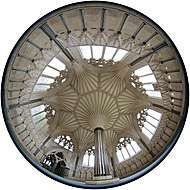 Fisheye used to capture entire Wells Cathedral Chapter House room
Fisheye used to capture entire Wells Cathedral Chapter House room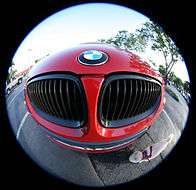 Canon 8–15mm zoom at 8mm of BMW M3
Canon 8–15mm zoom at 8mm of BMW M3 Image shot with a 16mm full-frame fisheye lens before and after remapping to rectilinear perspective.[n 1]
Image shot with a 16mm full-frame fisheye lens before and after remapping to rectilinear perspective.[n 1]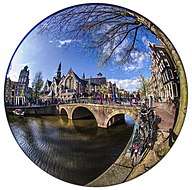 Circular fisheye view of Oude Kerk Amsterdam
Circular fisheye view of Oude Kerk Amsterdam.gif) Comparison of conventional (rectilinear) mapping function with four different fisheye mapping functions, given a constant focal length.
Comparison of conventional (rectilinear) mapping function with four different fisheye mapping functions, given a constant focal length.
Other applications
- Many planetariums now use fisheye projection lenses to project the night sky or other digital content onto the interior of a dome.
- Fish-eye lenses are used in POV pornography to make things right in front of the camera look bigger.
- Flight simulators and visual combat simulators use fisheye projection lenses in order to create an immersive environment for pilots, air traffic controllers, or military personnel to train in.
- Similarly, the IMAX Dome (previously 'OMNIMAX') motion-picture format involves photography through a circular fisheye lens, and projection through the same onto a hemispherical screen.
- Scientists and resource managers (e.g., biologists, foresters, and meteorologists) use fisheye lenses for hemispherical photography to calculate plant canopy indices and near-ground solar radiation. Applications include evaluation of forest health, characterization of monarch butterfly winter roosting sites, and management of vineyards.
- Astronomers use fisheye lenses to capture cloud cover and light pollution data.
- Photographers and videographers use fisheye lenses so they can get the camera as close as possible for action shots whilst also capturing context, for example in skateboarding to focus on the board and still retain an image of the skater.
- The "eye" of the HAL 9000 computer from 2001: A Space Odyssey was constructed using a Fisheye-Nikkor 8 mm f/8 lens.[58] HAL's point-of-view was filmed using a Fairchild-Curtis 'bug-eye' lens originally designed for films in the Cinerama 360 dome format.[59]
- The first music video to be shot completely with fisheye lens was for the Beastie Boys song "Hold It Now, Hit It" in 1987.
- In Computer Graphics, circular fisheye images can be used to create environment maps from the physical world. One complete 180-degree wide angle fisheye image will fit to half of cubic mapping space using the proper algorithm. Environment maps can be used to render 3D objects and virtual panoramic scenes.
- Many personal weather station online cameras around the world upload fisheye images of the current local sky conditions as well as a previous day time-lapse sequence with climate conditions such as temperature, humidity, wind and rainfall amounts.[60]
Mapping function
The subject is placed in the image by the lens according to the mapping function of the lens. The mapping function gives , the position of the object from the center of the image, as a function of , the focal length, and , the angle from the optical axis. is measured in radians.
| Subject | 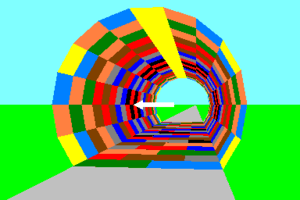 Original tunnel to be photographed, with camera looking from inside center to left wall. | ||||
|---|---|---|---|---|---|
| Normal | Fisheye[61][44] | ||||
| Rectilinear | Stereographic[62] | Equidistant | Equisolid angle | Orthographic | |
| Other names | gnomonic, perspective, conventional | panoramic, conform, planisphere | linear, linear-scaled | equal-area | orthogonal |
| Image |  |
 |
 |
 |
 |
| Mapping function[44] | [lower-alpha 1] | ||||
| Notes | Works like the pinhole camera. Straight lines remain straight (distortion free). has to be smaller than 90°. The aperture angle is gaged symmetrically to the optical axis and has to be smaller than 180°. Large aperture angles are difficult to design and lead to high prices. | Maintains angles. This mapping would be ideal for photographers because it doesn't compress marginal objects as much. Samyang is the only manufacturer to produce this kind of fisheye lens, but it is available under different brand names. This mapping is easily implemented by software. | Maintains angular distances. Practical for angle measurement (e.g., star maps). PanoTools uses this type of mapping. | Maintains surface relations. Every pixel subtends an equal solid angle, or an equal area on the unit sphere. Looks like a mirror image on a ball, best special effect (unsophisticated distances), suitable for area comparison (clouds grade determination). This type is popular but it compresses marginal objects. The prices of these lenses are high, but not extreme. | Maintains planar illuminance. Looks like an orb with the surroundings lying on < max. 180° aperture angle. Highly distorted near the edge of the image, but image in center is less compressed. |
| Examples[63][64][65] | (numerous) |
|
|
|
|
- Details
Other mapping functions (for example Panomorph Lenses) are also possible for enhancing the off-axis resolution of fisheye lenses.
With appropriate software, the curvilinear images produced by a fisheye lens can be remapped to a conventional rectilinear projection. Although this entails some loss of detail at the edges of the frame, the technique can produce an image with a field of view greater than that of a conventional rectilinear lens. This is particularly useful for creating panoramic images.
All types of fisheye lenses bend straight lines. Aperture angles of 180° or more are possible only with large amounts of barrel distortion.
See also
| Part of a series on |
| Graphical projection |
|---|
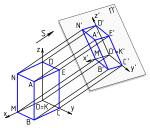 |
|
Views
|
|
Topics
|
- Azimuthal equidistant projection
- Dashcam
- Little planet effect
- Miniature faking
- Stereographic projection
- de:Fischaugenobjektiv Fisheye lens with more information in German
Notes
- Camera: a 35mm-format digital SLR, editing tool: Panorama Tools
References
- Wood, R. W. (August 1906). "Fish-Eye Views, and Vision under Water" (PDF). The London, Edinburgh, and Dublin Philosophical Magazine and Journal of Science. 6. XII (LXVIII): 159–161. doi:10.1080/14786440609463529.
- Bond, W. N. (November 1922). "A Wide Angle Lens for Cloud Recording". The London, Edinburgh, and Dublin Philosophical Magazine and Journal of Science. 6. XLIV (CCLXIII): 999–1001. doi:10.1080/14786441208562576. Retrieved 6 November 2018.
- Hill, Robin (July 1924). "A lens for whole sky photographs". Quarterly Journal of the Royal Meteorological Society. 50 (211): 227–235. Bibcode:1924QJRMS..50..227H. doi:10.1002/qj.49705021110.
- Henry Horenstein (2005-04-20). Black and White Photography: A Basic Manual. Little, Brown. p. 55. ISBN 9780316373050.
- Rudolf Kingslake (1989-10-28). "Reversed Telephoto Lenses: II. The Fish-Eye Lens". A history of the photographic lens. pp. 145–150. ISBN 9780124086401.
- David Brooks (1982). Lenses and lens accessories: a photographer's guide. p. 29. ISBN 9780930764340.
- Stafford, Simon; Hillebrand, Rudi; Hauschild, Hans-Joachim (2004). The New Nikon Compendium. Lark Books. pp. 209–210. ISBN 1-57990-592-7.
- Veronica della Dora, "Mountains as a Way of Seeing: From Mount of Temptation to Mont Blanc", in Emily Goetsch, Mountains, Mobilities and Movement, 2017, ISBN 1137586354, p. 205
- McGuffie, K.; Henderson-Sellers, A. (October 1989). <1243:AACOCO>2.0.CO;2 "Almost a Century of "Imaging" Clouds Over the Whole-Sky Dome". Bulletin of the American Meteorological Society. 70 (10): 1243–1253. doi:10.1175/1520-0477(1989)070<1243:AACOCO>2.0.CO;2.
- GB Application 225398, "Improvements in photographic lenses", published 4 December 1924, assigned to R & J Beck Ltd
- Miyamoto, Kenro (1964). "Fish Eye Lens". Journal of the Optical Society of America. 54 (8): 1060–1061. doi:10.1364/JOSA.54.001060.
- Ray, Sidney (1999). "Fisheye lens photography". Scientific Photography and Applied Imaging. Burlington, Massachusetts: Focal Press. p. 535. ISBN 978-0-240-51323-2. Retrieved 7 November 2018.
- Beck, Conrad (1925). "Apparatus to photograph the whole sky". Journal of Scientific Instruments. 2 (4): 135–139. doi:10.1088/0950-7671/2/4/305.
- "1920s Hill's Cloud Camera with Hill Sky lens made by Beck London". Novacon. Retrieved 7 November 2018.
- DE Grant 620538, "Abänderung eines Weitwinkelobjektivs (Modification of a wide-angle lens)", issued 23 October 1935, assigned to Allgemeine Elektricitäts-Gesellschaft
- "AEG Weitwinkelobjektiv patent information". Retrieved 7 November 2018.
- "Umbo (Otto Maximilian Umbehr)". Retrieved 7 November 2018.
- Cavina, Marco. "AEG Fisheye 17mm f/6,3 del 1935 e Nikkor Fisheye 16,3mm f/8 del 1938: Le prove del travaso tecnologico nel campo dell'ottica fra Germania e Giappone negli anni del patto d'acciaio" [AEG Fisheye 17mm f/6,3 of 1935 and Nikkor Fisheye 16,3mm f/8 of 1938: Proof of optical field technology transfer between Germany and Japan during the Pact of Steel era]. Retrieved 8 November 2018.
- "Fisheye Camera". Nikon. Archived from the original on 11 February 2001. Retrieved 8 November 2018.
- "History of Nikon Cameras: Release of Fisheye Camera". Nikon. Archived from the original on 6 February 2001. Retrieved 8 November 2018.
- "Fisheye Camera". Nikon Imaging Products. Retrieved 8 November 2018.
- Levett, Gray (1998). "The Nikon Legend - Part LI" (PDF). The Grays of Westminster Gazette. No. 52. London, England: Grays of Westminster. p. 8. Retrieved 8 November 2018.
- Crane, Ralph (photographer) (July 1, 1957). "Views along a pole". Life. Vol. 43 no. 1. Time-Life. p. 16. Retrieved 9 November 2018.
- US Grant 2247068, "Anastigmatic photographic objective", issued 24 June 1941, assigned to Carl Zeiss, Jena
- Gardner, Irvine C.; Washer, Francis E. (1948). "Lenses of Extremely Wide Angle for Airplane Mapping". Journal of the Optical Society of America. 38 (5): 421–431. doi:10.1364/JOSA.38.000421. Direct URL from NIST
- DE Grant 672393, "Lichtbildlinse (Photo lens)", issued 3 October 1935, assigned to Carl Zeiss SMT GmbH
- US Grant 2126126, "Photographic objective", issued 9 August 1938, assigned to Carl Zeiss SMT GmbH
- Cavina, Marco (10 March 2010). "Perimetar, Sphaerogon, Pleon: The definitive compendium about these super-wide and fisheye lenses of the '30s conceived by the firm Carl Zeiss Jena". Retrieved 9 November 2018.
- Silver, David (2012). "Highlights from the Carl Zeiss Jena Lens Collection". Retrieved 9 November 2018.
- "Edward K. Kaprelian, 1913-1997". Zeiss Historica Society. Retrieved 9 November 2018.
- Steinhard, Walter (photographs) (April 1947). "Lens Oddities". Popular Photography. Vol. 20 no. 5. Chicago: Ziff-Davis. pp. 82–83. Retrieved 9 November 2018.
- Long, Brian (2018). Nikon: A Celebration (Third ed.). Ramsbury, Marlborough: The Crowood Press Ltd. ISBN 978-1-78500-470-4. Retrieved 9 November 2018.
- Rørslett, Bjørn (27 November 2007). "Fisheye Lenses for Nikon 'F' Mount". Retrieved 9 November 2018.
- "8mm f/8 Fisheye-Nikkor Lens". Grays of Westminster. 20 September 2012. Retrieved 9 November 2018.
- Ohshita, Kouichi. "NIKKOR - The Thousand and One Nights No.6: OP Fisheye-NIKKOR 10mm F5.6". Nikon Imaging. Retrieved 9 November 2018.
- US Grant 3524697, Isshiki Masaki & Matsuki Keiji, "Achromatic super wide-angle lens", issued 18 August 1970, assigned to Nikon Corp
- Sato, Haruo. "NIKKOR: The Thousand and One Nights No. 53: Ai AF Fisheye-Nikkor 16mm F2.8D". Nikon Imaging. Retrieved 13 November 2018.
- "Course of History". Ricoh Imaging. Retrieved 10 November 2018.
- "Fish-eye-Takumar 1:11/18mm". Takumar Field Guide. Retrieved 10 November 2018.
- "Minolta 18mm 1:95 Fisheye (MC)". artaphot. Retrieved 10 November 2018.
- "Fish-eye-Takumar 1:4/17". Takumar Field Guide. Retrieved 10 November 2018.
- "Minolta 16mm 1:2.8 Fisheye (MC/MD)". artaphot. Retrieved 10 November 2018.
- US Grant 3589798, Ogura Toshinobu, "Wide-angle lens system with corrected lateral aberration", issued 29 June 1971, assigned to Minolta Camera Kabushiki Kaisha
- Bettonvil, Felix (6 March 2005). "Imaging: Fisheye lenses". WGN. International Meteor Organization. 33 (1): 9–14. Bibcode:2005JIMO...33....9B.
- 4.5mm F2.8 EX DC Circular Fisheye
- "Additional Information on Fisheye-Nikkor 6mm f/2.8 lens". Malaysian Internet Resources. Retrieved 2008-11-11.
- "Additional Information on Fisheye-Nikkor 6mm f/2.8 lens: Late 70s". Malaysian Internet Resources. Retrieved 2008-11-11.
- Laurent, Olivier Laurent (23 April 2012). "Rare extreme wide-angle Nikkor lens goes on sale". British Journal of Photography. Archived from the original on 25 April 2012. Retrieved 24 April 2012.
- Entaniya Fisheye 250 MFT - Micro Four Thirds system lens - 250° Fisheye Lens, entapano.com, retrieved on 15 November 2016
- Venus Laowa 4mm F2.8 Fisheye MFT, dpreview, 20 April 2018, retrieved 30 September 2018
- Sheppard, Rob (2006). The Magic of Digital Nature Photography. ISBN 9781579907730.
- For an equisolid angle projection (typical of full-frame fisheyes), the angle of view is double , the angle from the optical axis, and the resulting formula is , where which comes from solving the mapping function for ; Dyxum, Gustavo Orensztajn
- "Cameras from Nikon - DSLR and Digital Cameras, Lenses, & More".
- "190 Degree FOV Miniature Fisheye Lens". Archived from the original on 2012-10-30. Retrieved 2012-02-13.
- Miniature fisheye lenses
- "TheFishList - Pentax DA 10-17 -".
- "The Curves of ESO's Headquarters". ESO Picture of the Week. Retrieved 26 February 2014.
- Luhm, Thorsten (1 May 2017). "Der HAL 9000 stammt von Nikon (oder so)" [The HAL 9000 is from Nikon (maybe)]. Oberlehrer2. Retrieved 7 November 2018.
- Welkos, Robert W. (November 27, 2003). "Tracking HAL's Odyssey". Los Angeles Times. Retrieved 7 November 2018.
- url=http://www.bloomsky.com
- "Samyang 8 mm f/3.5 Aspherical IF MC Fish-eye review - Introduction - Lenstip.com".
- Charles, Jefrey R. (4 December 2009). "Review of Samyang 8 mm f/3.5 Proportional Projection Ultra-wide Angle Lens" (PDF). Versacorp. Retrieved 6 November 2018.
- Thoby, Michel (6 November 2012). "About the various projections of the photographic objective lenses". Retrieved 6 November 2018.
- Toscani, Pierre (20 December 2010). "Fisheyes". Retrieved 6 November 2018.
- "Fish-eye lenses". Kurazumi Office. Retrieved 14 November 2018.
- Thoby, Michel (20 December 2006). "Comparaison de deux objectifs Fisheye: Sigma 8mm f/4 et Nikkor 10,5mm f/2,8" [Comparison of two Fisheye lenses: Sigma 8mm f/4 and Nikkor 10.5mm f/2.8]. Retrieved 14 November 2018.
External links
| Wikimedia Commons has media related to Fisheye lenses. |
- Fisheye projection theory
- Vascon, Luca (2007). "the fish list". Archived from the original on 7 December 2016.
- Various fisheye projections
- Kumler, James "Jay"; Bauer, Martin (2000). Fish-eye lens designs and their relative performance. International Symposium of Optical Science and Technology. San Diego, California: SPIE. doi:10.1117/12.405226. Alternative archived URL


.svg.png)
